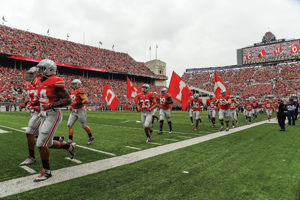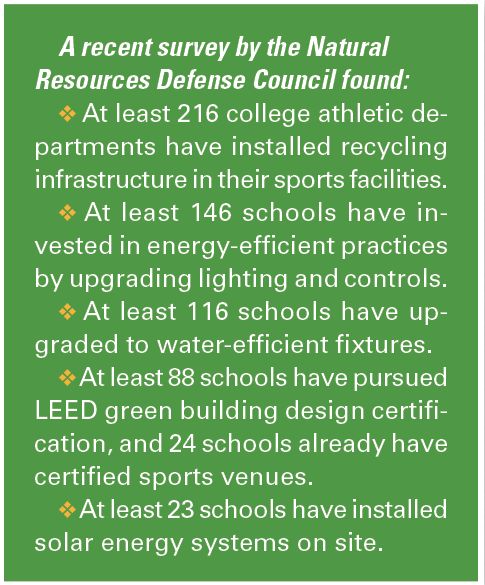If any of the 105,000 fans who pack Ohio Stadium on a fall Saturday want to throw something away, they’ll have to look awfully hard for a simple trash can.
Those don’t exist at the home of Ohio State’s football team. What those fans will find are 75 zero-waste stations throughout the concourses.
 |
Ohio State has taken a zero-waste approach at Ohio Stadium.
Photo by: Getty Images |
Trash is emptied in either a recycling bin for plastics or a compost collector for items that will decompose. Candy wrappers and snack food bags are typically the only materials produced at Ohio Stadium that don’t fit in either recycling or composting.
Sodexo worked with the school on serving food items in trays that would decompose when the program started in 2011. Levy has since moved into that role as the school’s food and beverage provider.
Now, in its third season of using the zero-waste approach, the Buckeyes are diverting 90 percent or more of their waste from home football games away from landfills.
“The hope is that we can use this as a test for the rest of campus,” said Corey Hawkey, Ohio State’s sustainability coordinator.
Zero-waste initiatives are starting to spread to college athletic departments across the country. Hawkey credited Colorado for being a leader in recycling and composting efforts, while many others like Kansas and Arizona State are embarking on efforts to leave no trash behind from their sporting events.
“Sustainability makes sense for business and economic purposes,” Hawkey said.
Robin Harris, executive director of the Ivy League, said one of her missions is to prove that there is a sound business case for sustainability measures.
Several Ivy League schools have plans to reduce waste. Princeton and Harvard have campuswide conservation efforts, including investments in solar energy.
The Ivy League’s official website is one of the few conference sites with a dedicated page to sustainability. The Ivy Green Initiative is a partnership between the conference and the Natural Resources Defense Council, an environmental adviser to U.S. pro sports leagues. They’re working together to provide environmental resources and guidance for all Ivy League athletic departments. That could include solar panels, water conservation and zero-waste efforts.
“It’s not just about athletics, it’s about what we can do across campus,” Harris said.
Those trends are becoming more common across the country. At Arizona State, the school has installed solar panels at 10 different sports facilities, making the appropriately named Sun Devils the leader in solar, according to the NRDC.
North Texas has taken a similarly aggressive approach with wind by putting up three 121-foot-tall turbines next to its football stadium for power.
On the conservation front, NRDC credits Minnesota for saving $410,000 annually on its power bill across eight athletic facilities for measures such as lights that are activated by motion detectors.
“What we like is that it gives us a well-coordinated platform to talk to the schools about,” Harris said of the Ivy League’s partnership with the NRDC.
Ohio State has found its zero-waste program to be a sponsorship platform as well. Working with its marketing rights holder, IMG College, the Buckeyes have brought on Rumpke Consolidated, a waste hauling company, and the Solid Waste Authority of Central Ohio to help fund the zero-waste efforts.
The most significant cost for the program comes in the form of manpower. Ohio State in the past hired 65 to 70 high school students to act as educators at each zero-waste station. As Buckeye fans have become more aware and understanding of the bins, fewer workers have been necessary.
This season, Ohio State decided to hire only 35 students to work the bins.
“The fans have caught on,” Hawkey said. “It’s funny. We started this by following in Colorado’s footsteps. There has been an explosion of other efforts like this. They’re popping up all over. We’re going to see it grow exponentially.”





